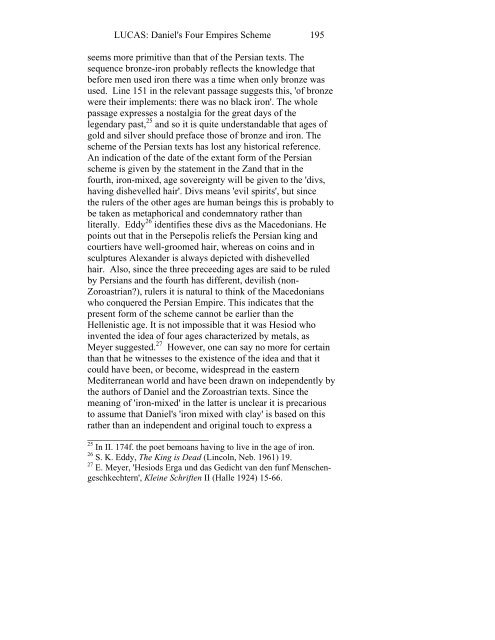the origin of daniel's four empires scheme re ... - Tyndale House
the origin of daniel's four empires scheme re ... - Tyndale House
the origin of daniel's four empires scheme re ... - Tyndale House
Create successful ePaper yourself
Turn your PDF publications into a flip-book with our unique Google optimized e-Paper software.
LUCAS: Daniel's Four Empi<strong>re</strong>s Scheme 195<br />
seems mo<strong>re</strong> primitive than that <strong>of</strong> <strong>the</strong> Persian texts. The<br />
sequence bronze-iron probably <strong>re</strong>flects <strong>the</strong> knowledge that<br />
befo<strong>re</strong> men used iron <strong>the</strong><strong>re</strong> was a time when only bronze was<br />
used. Line 151 in <strong>the</strong> <strong>re</strong>levant passage suggests this, '<strong>of</strong> bronze<br />
we<strong>re</strong> <strong>the</strong>ir implements: <strong>the</strong><strong>re</strong> was no black iron'. The whole<br />
passage exp<strong>re</strong>sses a nostalgia for <strong>the</strong> g<strong>re</strong>at days <strong>of</strong> <strong>the</strong><br />
legendary past, 25 and so it is quite understandable that ages <strong>of</strong><br />
gold and silver should p<strong>re</strong>face those <strong>of</strong> bronze and iron. The<br />
<strong>scheme</strong> <strong>of</strong> <strong>the</strong> Persian texts has lost any historical <strong>re</strong>fe<strong>re</strong>nce.<br />
An indication <strong>of</strong> <strong>the</strong> date <strong>of</strong> <strong>the</strong> extant form <strong>of</strong> <strong>the</strong> Persian<br />
<strong>scheme</strong> is given by <strong>the</strong> statement in <strong>the</strong> Zand that in <strong>the</strong><br />
<strong>four</strong>th, iron-mixed, age sove<strong>re</strong>ignty will be given to <strong>the</strong> 'divs,<br />
having dishevelled hair'. Divs means 'evil spirits', but since<br />
<strong>the</strong> rulers <strong>of</strong> <strong>the</strong> o<strong>the</strong>r ages a<strong>re</strong> human beings this is probably to<br />
be taken as metaphorical and condemnatory ra<strong>the</strong>r than<br />
literally. Eddy 26 identifies <strong>the</strong>se divs as <strong>the</strong> Macedonians. He<br />
points out that in <strong>the</strong> Persepolis <strong>re</strong>liefs <strong>the</strong> Persian king and<br />
courtiers have well-groomed hair, whe<strong>re</strong>as on coins and in<br />
sculptu<strong>re</strong>s Alexander is always depicted with dishevelled<br />
hair. Also, since <strong>the</strong> th<strong>re</strong>e p<strong>re</strong>ceeding ages a<strong>re</strong> said to be ruled<br />
by Persians and <strong>the</strong> <strong>four</strong>th has diffe<strong>re</strong>nt, devilish (non-<br />
Zoroastrian?), rulers it is natural to think <strong>of</strong> <strong>the</strong> Macedonians<br />
who conque<strong>re</strong>d <strong>the</strong> Persian Empi<strong>re</strong>. This indicates that <strong>the</strong><br />
p<strong>re</strong>sent form <strong>of</strong> <strong>the</strong> <strong>scheme</strong> cannot be earlier than <strong>the</strong><br />
Hellenistic age. It is not impossible that it was Hesiod who<br />
invented <strong>the</strong> idea <strong>of</strong> <strong>four</strong> ages characterized by metals, as<br />
Meyer suggested. 27 However, one can say no mo<strong>re</strong> for certain<br />
than that he witnesses to <strong>the</strong> existence <strong>of</strong> <strong>the</strong> idea and that it<br />
could have been, or become, widesp<strong>re</strong>ad in <strong>the</strong> eastern<br />
Mediterranean world and have been drawn on independently by<br />
<strong>the</strong> authors <strong>of</strong> Daniel and <strong>the</strong> Zoroastrian texts. Since <strong>the</strong><br />
meaning <strong>of</strong> 'iron-mixed' in <strong>the</strong> latter is unclear it is p<strong>re</strong>carious<br />
to assume that Daniel's 'iron mixed with clay' is based on this<br />
ra<strong>the</strong>r than an independent and <strong>origin</strong>al touch to exp<strong>re</strong>ss a<br />
_________________________<br />
25 In II. 174f. <strong>the</strong> poet bemoans having to live in <strong>the</strong> age <strong>of</strong> iron.<br />
26 S. K. Eddy, The King is Dead (Lincoln, Neb. 1961) 19.<br />
27 E. Meyer, 'Hesiods Erga und das Gedicht van den funf Menschen-<br />
geschkechtern', Kleine Schriften II (Halle 1924) 15-66.
















